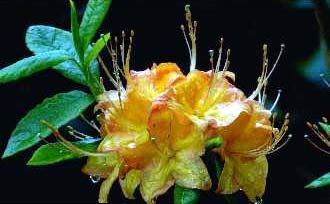Mulching is the simplest and most natural way to protect your garden from dryness, weather extremes, bruising, pests, weeds, and erosion. Even better, a good mulch will add valuable nutrients to your soil as it protects.
Mulching is a natural process; it occurs spontaneously, and that is why plants have been able to survive a great many hardships and disasters through the ages. Snow, leaves, dead foliage of annual plants - these are some of Nature's mulches which have protected plants from the rigors of harsh seasonal conditions since time began.
Whether a fluffy blanket of straw, a rich brown carpet of cocoa bean shells, or a mantle of sawdust, that protective covering for the vegetable garden or the flower bed serves many essential functions.
Mulching is a Must
Mulch performs in several wondrous ways - not only does it conserve moisture, but it also protects topsoil from weeds and erosion, guards plants against weather extremes, and provides a protective cushion beneath ripening produce. It even discourages weeds and garden pests. Organic mulches have a further benefit - as they decompose, their nutrients are absorbed into the structure of the soil. The warm, moist soil under a good mulch will attract earthworms and other tiny organisms which not only loosen the soil as they move through it, but whose by-products also improve soil richness.
How Thick to Mulch
Mulch layers must not be so heavy as to block air circulation, moisture, or the sun's warmth. The smaller-grade mulches – such as sawdust and woodchips - should be applied 2 to 3 inches thick, while the lighter mulches -straw, salt hay, pine needles - should be spread 3 to 6 inches deep.
Mulching Saves Labor
Mulching eliminates many of those time-consuming, back-aching jobs, like weeding and cultivating, that are so essential to a productive garden.
When you use mulch for your winter garden, you are giving it more than warmth; you are protecting it from alternate thawing and freezing, and from cold winds and winter sun.
Mulching also keeps plants cool when the summer heat sets in. During hot weather, mulching is the easiest way for the gardener to regulate soil temperature and conserve moisture.
Mulching Materials
Your choice of mulching materials is simply a matter of dollars and sense. The general rule of thumb is: use what is available locally and is the least costly. Buying mulch materials with fancy names or qualities, simply because they are attractive, will do nothing to improve the quality of your plants -although it may make your garden more aesthetically pleasing.
No matter where you live, there will be a variety of organic mulches available. The bark chips of coniferous trees generally come in a variety of sizes and make an attractive covering that is permeable to rainwater. Buckwheat hulls and cocoa bean shells are both dark brown coverings that are appropriate for ornamental plantings such as rose beds. Other commonly used mulches include leaves, manures, peanut shells, peat moss, pine needles, salt hay, saw dust, seaweed, straw, cornstalks, and wood chips.
The most popular and most beneficial mulch material is compost - free for the making and highly recommended for improving the quality of your soil. Items usually considered as household refuse, like corncobs, coffee grounds, grass clippings, and newspapers can also be used successfully for mulching. However, avoid using glossy magazines and colored inks since they are less biodegradable.
How to Apply
Mulches are easy to apply. But before applying any mulch, your garden should be weeded, lightly cultivated, and moist. The mulching process should start in fall after a general garden cleanup. Spread a protective layer of mulch over plants; the thickness will depend on climate conditions in your area and the plants you want to protect.
In spring, pull back mulch and plant young seedlings. Then, work the mulch between plants, being careful not to cover them. When the midsummer heat begins to set in, remove the old mulch and add a fresh layer to last through fall.
STEPS TO SUCCESSFUL MULCHING
First, clean and cultivate the planting area. Dig out unwanted volunteer seedings.
Take care to remove all weed roots, especially tenacious grasses, to prevent their regermination under the mulch.
Organic materials are best for mulching; bark mulch (pictured here), grass clippings, and straw are among the most popular materials.
Spread mulch layer 2 to 6 inches thick depending upon the size and density of material. Because bark chips do not compress readily, they can be applied more thickly than grass clippings.
When properly applied, the layer of mulch can be attractive protection for your garden.
TIPS:
Before mulching, weed and water your garden. Fertilizer should also be applied beforehand, as organic materials will decompose quicker under a layer of mulch.


